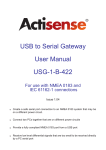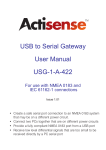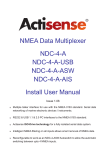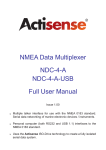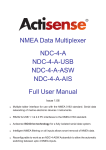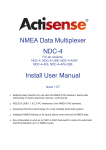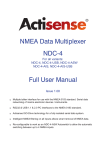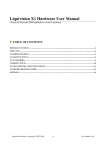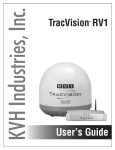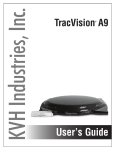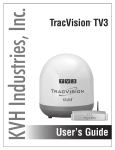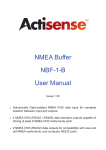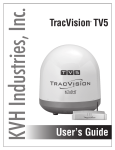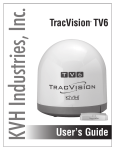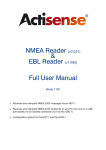Download USG-1-A-485 User Manual issue 1.01.indd
Transcript
USB to Serial Gateway User Manual USG-1-A-485 For use with RS485 Industrial Interfaces and Maritime IEC 61162-2 connections Issue 1.01 • Create a safe serial port connection to an RS485 network or an IEC61162-2 compliant marine connection that may be on a different power circuit. • Provide a fully compliant RS485 port from a USB port • Receive low level differential signals that are too small to be received directly by a PC serial port USB to Serial Gateway - USG-1-A-485 Contents Important Notices Notices Foreword Introduction RS485 & IEC61162-2 USG-1 solutions 4 4 4 4 4 5 Features Software updates RS485 Interfacing The basics 5 5 6 6 Opening the USG-1 USG-1 connections Connecting Devices 6 7 8 Solution #1 - Ground loops Solution #2 - Different standards Solution #3 - PC has no serial port The RS485 signals RS485 Connections Connecting to a 3-pin RS485 Listener or Talker (IEC 61162-2) Connecting to a Personal Computer RS232 port 5 5 5 6 8 9 9 USB Driver Installation 10 USB Configuration 12 Troubleshooting guide 14 Specifications Company Information 15 16 Step by step guide Step by step guide Diagnostic LED © 2007 Active Research Limited 10 12 14 Page 3 Actisense™ Important Notices Foreword The Actisense™ USB to Serial Gateway (USG-1-485) is intended for use in a marine environment, but only below decks. If the unit is to be used in a more severe environment, such use may be considered misuse under the seller’s warranty. Actisense™ recognises that instructions are often skipped, so we have aimed to write this document in an informative, yet direct manner that will aid the user. We have tried to cover all the points a typical user may need to know. Please read all sections before installing and using the Actisense™ USB to Serial Gateway product. The Actisense™ USG-1-485 has been certified to comply with the European directive for Electro-Magnetic Compatibility (EN60945), and is appropriately CE marked. Operation of the unit should be in conjunction with appropriate CE approved shielded connectors and cabling used in accordance with the CE directive EN60945. Any EMC related issues should be reported to Active Research immediately to allow the company to rectify or resolve EMC related problems in accordance with its obligations under EN60945. If the unit is connected such that compliance failure occurs beyond the company’s control, the company shall not be held responsible for compliance failure until suitable EMC guidelines for connection are seen to have been taken. Notices When using this document, keep the following in mind: The products described in this manual and the specifications thereof may be changed without prior notice. To obtain up-to-date information and/or specifications, contact Active Research Limited or visit the Actisense™ website (www.actisense.com). Active Research Limited will not be liable for infringement of copyright, industrial property right, or other rights of a third party caused by the use of information or drawings described in this manual. All rights are reserved: The contents of this manual may not be transferred or copied without the expressed written permission of Active Research Limited. Active Research Limited will not be held responsible for any damage to the user that may result from accidents or any other reasons during operation of the user’s unit according to this document. © 2007 Active Research Limited Introduction The Actisense™ USB to Serial Gateway (USG-1-485) product developed out of the requirement to solve three fundamental problems with interfacing the industry RS485 communications standard to a PC. These are: 1. Ground loops. When the PC and the connected system have different ground potentials (or are totally different ground altogether), data can become corrupted and permanent damage can occur. 2. Different standards. When you buy a standard USB to serial converter, they normally provide PC standard RS232 port, whereas RS485 uses a differential bidirectional signalling system. This means that a standard USB to serial converter is incompatible with RS485 / IEC61162-2 that uses the RS485 electrical driver type. 3. PC has no serial port. Most modern PCs do not come with serial ports any more as these are being replaced by the new standard of USB. Furthermore, RS485 signals are not directly compatible with standard PC serial ports. Full information on the complete Actisense™ product range can be found on the Actisense™ website. RS485 & IEC61162-2 The port provided by the USG-1-A-485 will be referred throughout the document as “RS485” although the IEC61162-2 marine standard uses the same interface, and the two terms are interchangeable. The IEC61162-2 interface is not normally used in a bidirectional mode, however, and is generally referred to as a three-wire RS422 system. The differential signalling method and the output driver levels are compatible between the two systems. Page 4 USB to Serial Gateway - USG-1-A-485 USG-1 solutions Solution #1 - Ground loops Solution #3 - PC has no serial port PCs are often powered from a mains inverter, generator set or direct from mains supply when in dock, whereas the marine electronics are normally connected to the current marine battery set. This port appears on the PC system as a regular “COM” port, and so can be used with all standard navigation and display software. The first problem encountered when using a standard USB to serial converter (or a standard RS232 port) is that the ground of the PC is then shared with the connected system ground. This means that when you connect the two systems together, you are joining two different power systems. This can result in no visible problems, but more often it results in one of three consequences: 1. Data corruption - the data becomes garbled as the electrical data signal now floats on a noisy ground current flowing between the two power systems. 2. The PC crashes intermittently as ground currents flow across its sensitive electronic circuitry. This can cause permanent damage. 3. In the case of large ground loop faults, some components can melt / catch fire / fuses blow or earth leakage devices trip. The USG-1-485 solves all these problems by providing a safe, opto-isolated barrier between the two systems. Because the signal travels across this barrier as light, the signals do not share the same ground, and safety is assured as no current can flow between the two power systems. In addition, a built-in power isolator completes the isolation. Solution #2 - Different standards PC serial or “COM” ports use the RS232 standard. This uses a ground and a receive pin to get data from a connected system. Data is sent as voltages referenced to ground on a single transmit line. This type of drive is known as “single-ended”. In contrast, RS485 systems use a “differential” system, where a “Positive” data line and a “Negative” data line move in opposition to each other. Many installations without isolated outputs have been seen where the negative data line on a differential drive system has been connected to the ground of the PC. If you’re lucky, this may work, but if not, you will either simply get no data, or at worst, damage your equipment. The USG-1-485 solves this by using ingenious circuitry unique to Actisense in its bi-directional transmitter circuit. Please refer to the Interfacing section for more information. © 2007 Active Research Limited Many laptop and desktop PCs do not come equipped with RS232 type serial ports (which could be converted to an RS485 type using a simple converter) any more. The USG-1-485 solves this by creating a standard RS485 port from any PC USB port. Features Standard USB connection - Equipped with a type “A” USB connector to connect to a USB port or hub (USB v1.1 or v2.0 compliant). Opto-isolated ISO-Drive transceiver technology creates a transceiver, unique to Actisense, that is isolated to 1500 volts - say goodbye to ground loop issues! ISO-Drive allows a completely “floating” output to be created, making a safe connection to a PC an easy task. You can use the ISO-Drive output to safely transfer data to an RS485 device, or to another PC. The output automatically changes between differential and single ended drive depending upon the type of instrument it is connected to. When not transmitting, the USG-1-485 automatically switches to receive mode. The output becomes a differential input fully compliant with the RS485 specification. This allows the USG-1-485 to work correctly with long cable runs and in a noisy environment. Typical operating voltage is 2.0v to 12.5v. The unit can withstand -8/+12.5v continuously, and +/- 40v transients. The input is also compatible with RS232 signal levels. PC USB drivers supplied on disc - the drivers allow the USG-1 to appear as a standard “COM” port on the PC. Low current consumption - the USG-1-485 is powered directly from the USB port on your PC, so no extra power cables are required. Tough Polycarbonate case - certified to IP54 (Splash and dust proof) when used with both supplied cables. Software updates The USG-1 has no built-in firmware, but Actisense will be providing updates to the PC USB drivers free on our website, www.actisense.com when they become available. Page 5 Actisense™ RS485 Interfacing Opening the USG-1 The basics The USG-1 comes supplied with a factory installed connection cable with tinned solder wire ends. Using this cable means that you will not need to open the USG-1485 case to make your connections. RS485 interfaces are much like RS422 interfaces, but with the ability for the connection to be a listener or a talker depending upon port direction. The USG-1 transceiver changes direction automatically. When installed on a PC, the USB driver sets up a virtual communications port ”VCP” on the host PC. When data is sent to this port, the USG-1-485 transceiver automatically becomes a driver and sends data to the RS485 network. Once all data has been sent, the transceiver automatically switches back to receive mode. In addition, an optional link on the USG-1-485 board can be set to “echo” mode, where data on the bus sent from the USG-1-485 returns back to the PC. This link is factory set to “no echo”. Actisense™ produces a full range of products to solve many marine and other interfacing requirements. Please visit the Actisense™ website for full details on these and other Actisense™ interfacing products (NMEA Multiplexers, NMEA Buffers, and NMEA Autoswitches) as well as Depth sounders. If you need to use your own cable, Phoenix style connectors are provided within the USG-1-485 to allow you to connect it. A separate grommet is also provided for this purpose - simply slide it over your own cable before connecting it to the Phoenix style connectors. To open the USG-1-485, remove the two screws in the base of the USG-1, then slide off the top of the case. The grommets need to be slid off the top of the case in order to access the internal connections. You will be left with the USG-1-485 circuitry attached to the base of the unit and the two supplied cables attached to their connectors. Note: When opening the USG-1-485 case, be aware that the circuitry inside is not 100% protected against static electricity. Please ensure that, when opening the case, you use precautions against static damage - by only touching the connector block and by holding the unit by its base. In this way, the risks of static damage will be minimised. The RS485 signals RS485 uses a ”differential” signalling scheme, whereby two wires are used to transmit the data. These connections will be labelled as either “A” and “B“ or “+” and “-“ respectively, depending on the instrument and manufacturer. When connecting between different manufacturers, there can be some confusion, but it is simple and easy to remember: “A” connects to “+” and “B“ connects to “-“. © 2007 Active Research Limited Page 6 USB to Serial Gateway - USG-1-A-485 USG-1 connections 5 2 3 6 4 1 Figure 1 – Inside the USG-1 case Figure 1 shows an internal view of the USG-1 Printed Circuit Board (PCB). The USG-1 has both micro connectors and screw-terminal “Phoenix” type connectors. 1. A micro connector attached to the standard data cable that comes with the USG-1-485. This cable should be sufficient for most installations. The colour codes used for this cable are: Wire colour Function Black ISO-Drive Ground Orange ISO-Drive RS485 B/- Yellow ISO-Drive RS485 A/+ Brown ISO-Drive RS485 B/- Red ISO-Drive RS485 A/+ This cable also has a screen connection. This is not connected inside the USG-1: in most instances, simply connect this to ground at the instrument end, and this will provide correct screening of the signals on the USG-1-485 data cable. 2 Both sets of connections provide connections: ‘+/ A’, ‘-/B‘. This allows the USG-1-485 to interface to various different devices that require any combination of these outputs. Both sets are connected in parallel on the board. This allows a network to be created, by allowing a connection in from the RS485 network, and the second set used to connect to further devices on the network. Note: The connection marked “GND” on the connection block 3 is not USB or PC ground, it is connected to the isolated ground of the ISODrive circuit. In most installations, this GND should be left disconnected. It is only for use in special circumstances where an RS485 3-terminal type connection is required, and is reserved only for specialist installations. No damage will be caused by connecting to this GND in error, but it may result in missing or corrupted data if it is used incorrectly. Always follow the connection diagrams shown in this manual to ensure correct operation. 4. A micro-connector to connect to the supplied USB type A terminated cable. 3 This connector should not normally be removed: it is installed at the factory and is not customer serviceable. 1 2/3. An RS485 bidirectional connection. Two sets of screw-terminal Phoenix-style connectors (2 & 3 in figure 1) are provided to connect the RS485 network. These connectors are provided for use when the customer needs to use their own cable. © 2007 Active Research Limited The bottom set of three screw-terminal Phoenix-style connectors provide a second set of connections to the RS485 network, along with a reference to the floating ground of the USG-1-485 driver circuitry to use where required. 5. An indicator LED This LED flashes when data is sent from or received by the USG-1-485. 6. An echo-mode header Connecting the supplied link between pins 2 and 3 sets the “echo” mode, which returns all data sent by the PC. Connecting pins 1 and 2, sets the “no echo”, mode, which is the factory default. Page 7 Actisense™ Connecting Devices B/A/+ RS485 Net OUT B/A/+ GND RS485 Net IN Figure 2 – RS485 connections RS485 Connections Figure 2 shows a typical installation with an RS485 network connected into the lower connections of the connector (connection 3 on Figure 1), and the network continuing on via the second set of connections above. The USG-1-485 maintains full isolation of the PC from both ground and signal lines. The ground (GND) connection may be connected to the network as a reference ground. This is not the same as the PC ground - it is the isolated ground used by the RS485 transceiver on the USG-1-485. Notes: 1. It is recommended that all device interconnection cables used should meet the two-conductor, shielded, twisted pair configuration specification. The shield connection of these wires should be connected at the instrument end only to prevent ground loops. 2. Throughout these connection diagrams, the wire colours represent those actually used on the supplied Actisense USG-1-485 data cable. When using the supplied cable, simply use the colours indicated to connect to your network or instrument. 3. Refer to the Specifications section for the full details on input/output specifications. © 2007 Active Research Limited Page 8 USB to Serial Gateway - USG-1-A-485 Connecting to a 3-pin RS485 Listener or Talker (IEC 61162-2) B/A/+ GND RS485 Listener or Talker Figure 3 – RS485 / IEC 61162-2 port connections The USG-1 transceiver can be connected to an IEC611622 Listener, or Talker that requires a differential drive plus ground as shown in figure 3, The USG-1 serial port will default automatically to listen mode when no data is being sent (from an ‘RS485 Talker’) to the virtual serial port representing the USG-1-485 on the PC. Connecting to a Personal Computer RS232 port It is possible to connect the USG-1-485 to a PC’s serial communications (RS232) port, however, the resulting PC connection would not be bidirectional - as communication can only work one-way (either receive only, or transmit only, but not both). It is therefore, highly recommend to use an Actisense USG-1-422 model instead, using the RS232 connections detailed in that user manual. This method will allow full bidirectional isolated connection to a PC RS232 port. © 2007 Active Research Limited Page 9 Actisense™ USB Driver Installation The Actisense™ USG-1 makes use of a virtual serial port driver (know as the Virtual COM Port Driver) to interface between the USB port on the PC and the Actisense™ product. This driver allows software running on a PC to communicate with the Actisense™ USG-1 as if it was connected to a standard serial port on the PC, when in fact all communication is done over the USB connection. Step by step guide 1. Make sure the Actisense™ USG-1 is connected to an available USB port on the PC. The standard Windows™ ‘Found New Hardware Wizard’ window will then appear. Select the ‘No, not this time’ option, to allow driver installation from the Actisense™ CD which was supplied with your Actisense product. The required driver installation comes in two separate packages. The first driver is a called the ‘Serial Converter’ which converts the USB data packets to a serial data stream. The second driver, called the ‘Actisense USB Serial Port’, makes the USB connection appear as a COM port in the Windows™ Device Manager. The USG-1 with USB connection has been extensively tested with both Windows™ XP and Windows™ 98 SE. For the experienced Windows™ XP user who is used to installing drivers, this section will be very familiar. To all other Windows™ users, the required steps are detailed below to help with installation. The steps for Windows™ 98 SE are very similar to those of Windows™ XP and so are not detailed here. The Actisense™ CD also contains the USB drivers for Windows™ 2000. These drivers have not been tested by Actisense™, but should operate in the same manner as the Windows™ 98 SE and XP drivers. 2. Insert the Actisense™ CD, choose the ‘Install from a list or specific location’ option, and click ‘Next’. The required Linux drivers are already included in the Linux kernels from v2.4.20 and onwards. However, Actisense™ has not been able to test the compatibility of the USG-1 with USB and this driver. For MAC OS 8, 9, and X please contact Actisense™ for details (refer to the Company Information section). © 2007 Active Research Limited Page 10 USB to Serial Gateway - USG-1-A-485 3. Make sure the ‘Include this location in the search’ option is ticked, and use the ‘Browse’ button to locate the ‘USB Drivers’ directory on the Actisense™ CD. 5. The ‘USB Serial Converter’ driver is now installed, click ‘Finish’ to complete the wizard, and wait for the ‘Found New Hardware Wizard’ to appear again. 4. The ‘Actisense USB Serial Converter’ driver is not Microsoft Windows™ certified, but it has been ‘tried and tested’ for stable and reliable operation with the Actisense™ USG-1. Click ‘Continue Anyway’ to carry on with the installation. This second wizard will guide you through the ‘USB Serial Port’ driver installation. 6. Follow steps 1 to 5 above for the ‘USB Serial Port’ driver installation and click ‘Finish’ to complete. ‘Your new hardware is installed and ready to use’ will appear in the bottom right corner of your screen when the installation is complete. See the USB Driver Configuration section for details on how to find out which COM port number has been allocated to your Actisense™ device as well as how to change to a different COM port and configure the Baud rate. © 2007 Active Research Limited Page 11 Actisense™ USB Configuration To communicate with the USG-1, the COM port number that Windows™ has allocated to the USB port needs to be determined. The following guide will walk the user through this standard operation. Step by step guide 1. Make sure the Actisense™ USG-1 is connected to an available USB port on the PC. From the Windows™ ‘Control Panel’, open the ‘System Properties’ window and click on the ‘Hardware’ tab. The Actisense™ USB to Serial Gateway, USG-1 is completely USB port independent: it can be easily unplugged from one USB port and connected to another available USB port on the same PC without the COM Port number changing. To achieve this independent operation, plug the USG-1 into each required USB port that you require it to work with in turn, install the USB drivers and manually change the allocated COM port number to the same number for each USB port. Once configured, the COM port number will not change unless instructed to do so by the user. This is very useful when the USG-1 is working in unison with a software program that is set up to use a particular COM port, as the user does not need to re select a different COM port every time the PC re boots, or the cable is swapped between two USB ports. 2. Click on ‘Device Manager’ and expand the ‘Ports (COM & LPT)’ list by clicking on the ‘+’ sign next to it. You will find the ‘Actisense USG’ in the list, followed by the allocated COM port number. © 2007 Active Research Limited Page 12 USB to Serial Gateway - USG-1-A-485 3. Double click on the port icon for the ‘Actisense USG’ and the port properties window will appear. Click on the ‘Port Settings’ tab. Here you can set the default settings for the USG-1 device. It is not necessary to change the default settings here - as each software program will define these settings itself. 4. Click on the ‘Advanced’ button and choose a different COM Port number if required (to make it compatible with the software requiring the USG-1 RS485 data). The other settings are already optimised for the Actisense™ USG-1 and should be left in the default values. Click on ‘OK’ button to save the new settings. © 2007 Active Research Limited Page 13 Actisense™ Troubleshooting guide This guide will concentrate on all relevant troubleshooting issues above simple cable connection faults. Therefore, the cables between the USG-1 hardware and any other devices should be checked as a matter of course, before continuing with this guide. Diagnostic LED The USG-1 hardware has a bright LED that can be seen through the case to indicate when data is either received or transmitted. It can be used to debug potential problems. If you have both a talker and a listener connected, then you can analyse which is working by disconnecting one of them or by stopping the PC from sending data. Mode / Error condition Required user response LED does not flash when the PC is sending data Check that the PC program is sending data and that it has opened the comms port assigned (by user) or allocated (by Windows Device Manager) to the USG-1 LED does not flash when the Talker is sending data Check that the ‘Talker’ device is correctly connected to the USG-1-485, that it is powered on, and that it is sending data. In addition, the USB driver must be correctly installed and the PC software must have the assigned comms port open for the LED to flash No data is being received by the Listener, but LED is flashing as PC is sending Check that the ‘Listener’ device is correctly connected to the USG-1-485, that it is powered on, and that it is set to receive data at the Baud rate of the PC comms port. If there is a cable problem that has activated the short-circuit protection, the protective poly-fuses will have activated to protect the USG-1-485 from damage. In this case, remove the cable fault and wait 1 minute before reconnecting the USG-1 to the RS485 network. If the error persists, the USG-1-485 unit should be returned to Actisense™ (refer to the Company Information section). Please contact Actisense before returning the unit in order to obtain a Returns Number. Any returns sent without a Returns Number will incur a delay in being processed. Any returns that are not found to be faulty will incur the minimum servicing charge. Table 1 – Diagnostic LED colours © 2007 Active Research Limited Page 14 USB to Serial Gateway - USG-1-A-485 Specifications Parameter Conditions Min. Max. Unit From USB port 4.75 5.25 V Supply voltage = 5v (no load) 40 46 mA Supply voltage = 5v (output shorted) 75 80 mA Logical ‘1’ 2.0 15.0 V Logical ‘0’ -0.3 0.5 V - 1.0 mA Supply Supply voltage Supply current drawn from USB port RS485 Transceiver Input / Output Input voltage between +/Input current Differential input voltage Required level for data to be detected -0.2 0.2 V Output voltage between +/- and ground (under no load) Logical ‘1’ 0.0 0.5 V 4.5 5.0 V - 21 mA Output short circuit current (note 1) Logical ‘0’ At maximum load, differential drive voltage reduces to 2.1v Due to short circuit protection 50 55 mA Galvanic isolation From USB ground 1500 V Static discharge protection Yes 115200 bps Output current at max load of 100 ohm PC Communication settings Baud rate Both input & output Baud rates are set by the PC software settings 300 General Ambient temperature -20 +70 °C Table 2 – USG-1-485 specifications All specifications are taken with reference to an ambient temperature (TA) of +25°C. Note: 1. Short circuit may be applied indefinitely. The RS485 transceiver input / output may be short-circuited directly to a 30 volt battery supply without damage. A maximum current of 50mA will flow due to “polyfuse” auto-resetting fuse technology being used. © 2007 Active Research Limited Page 15 Actisense™ Company Information Active Research Limited 5, Wessex Trade Centre Ringwood Road Poole Dorset UK BH12 3PF Telephone: Fax: 01202 746682 (International : +44 1202 746682) 01202 746683 (International : +44 1202 746683) Actisense™ on the Web: For advice, support and product details E-mail: Website: [email protected] www.actisense.com Active Research on the Web: For specialist consultancy and customisation E-mail: Website: [email protected] www.activer.com © 2007 Active Research Limited Page 16
















